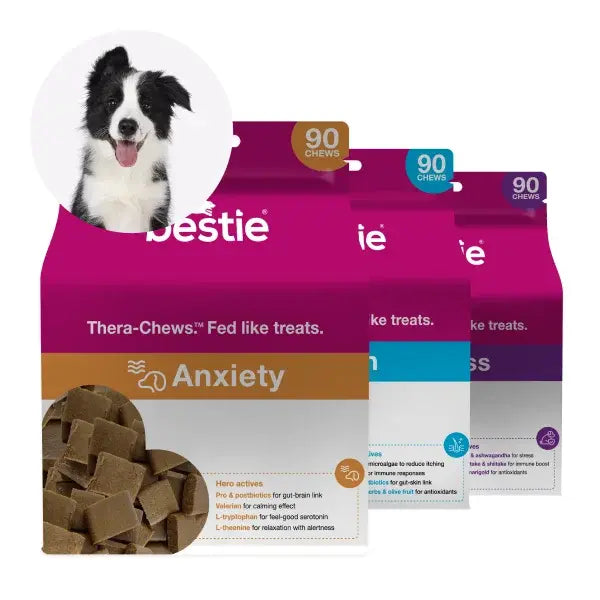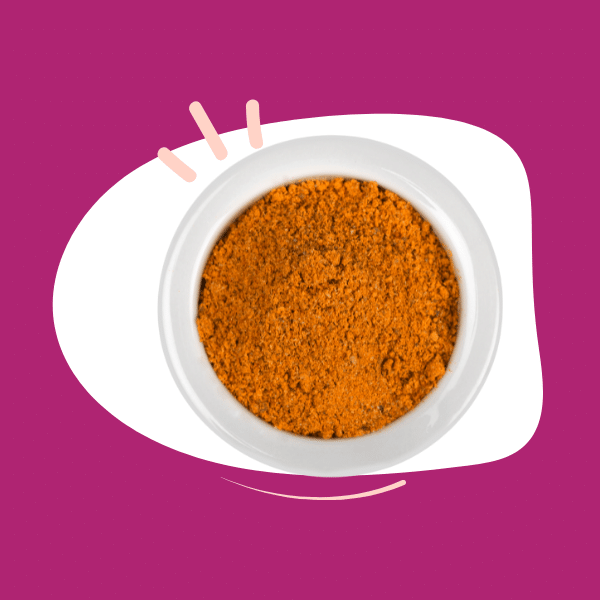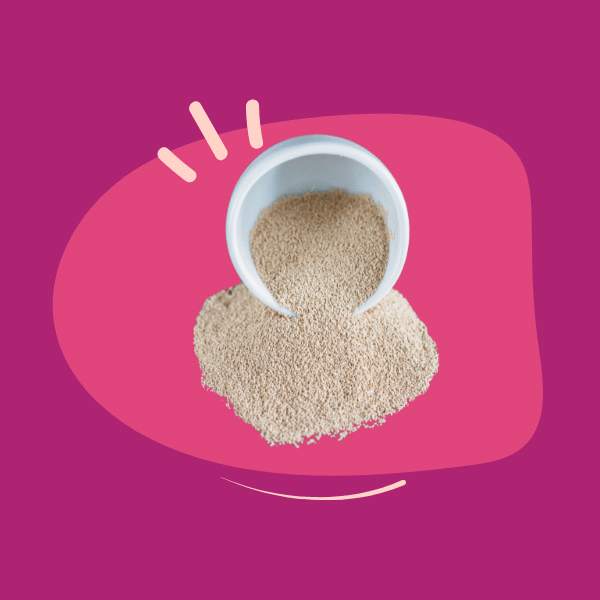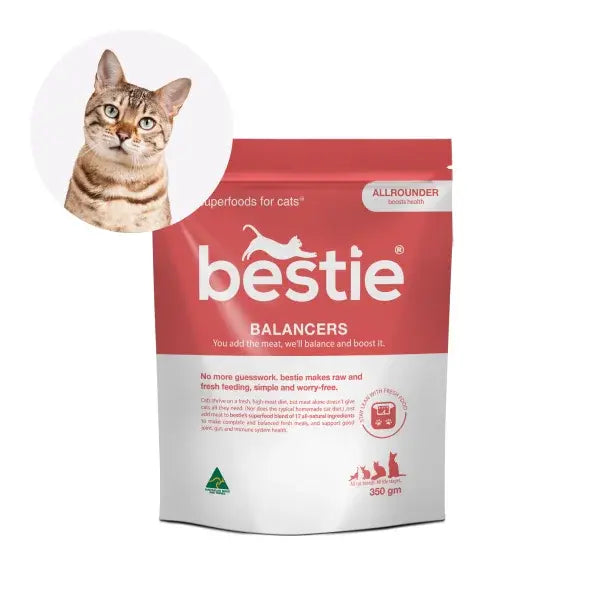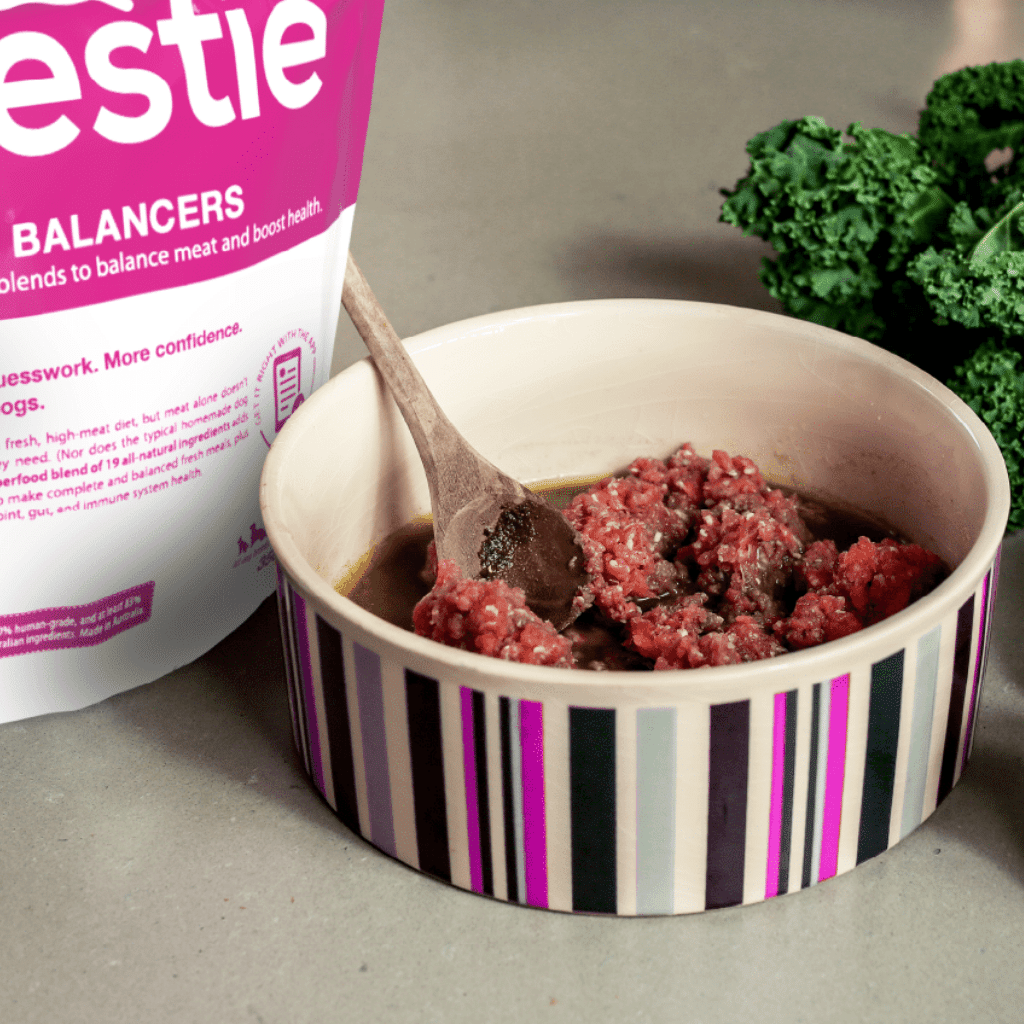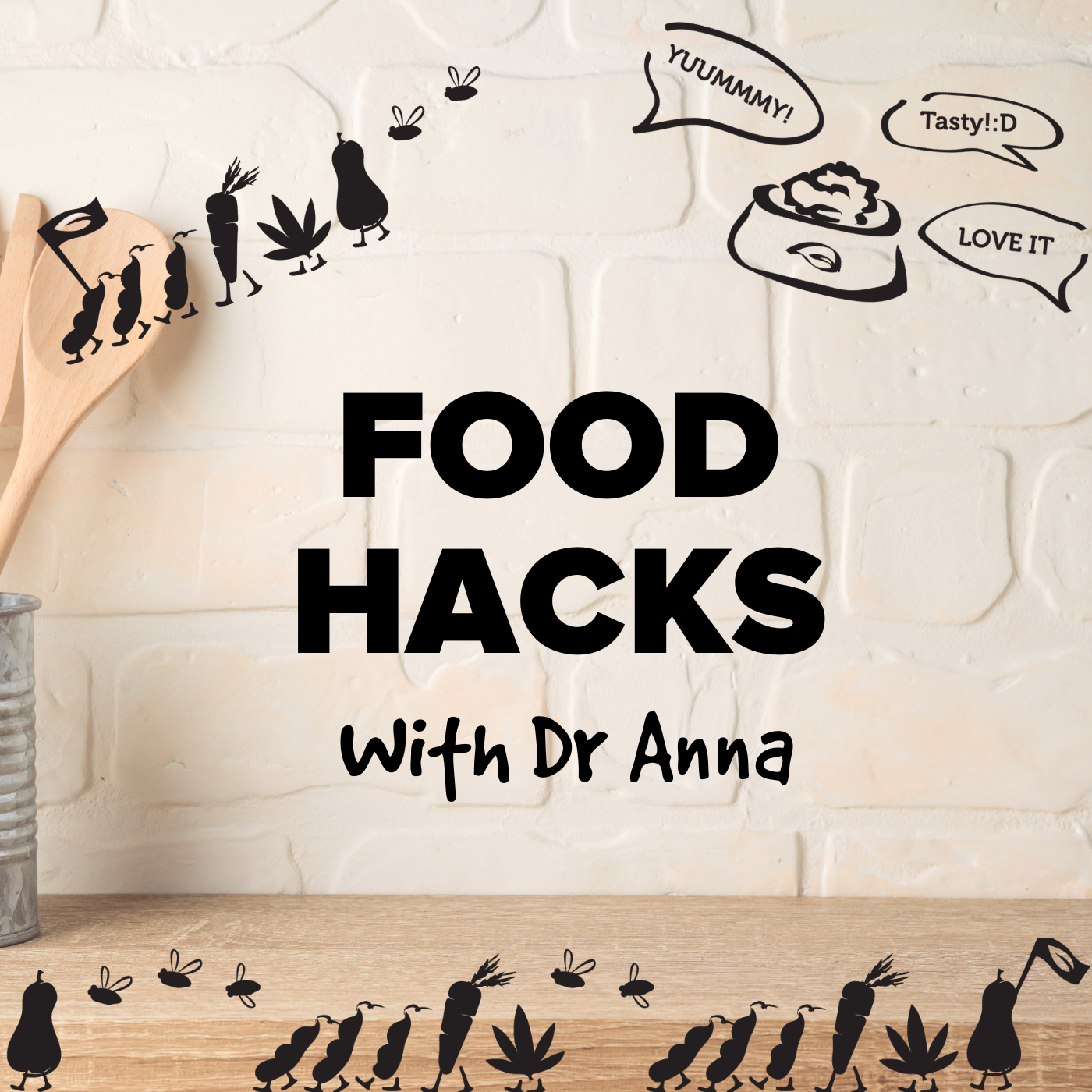In a nutshell:
-
Digestibility of raw diets are higher than kibble = Nutrients are more accessible
-
Dogs on raw diets show a range of health improvements like weight loss, energy, skin
-
Kibble is ultra-processed, prone to oxidation and typically high in carbs
-
Different approaches to raw feeding = BARF, PMR and DIY with bestie
-
“Complete and Balanced” formula diet using Bestie’s Balancer Supplement
-
Our Allrounder Balancing Supplement exceeds AAFCO requirements
-
How to transition your pet to a raw diet = Can take 7-30 days
According to the American Veterinary Medical Association (AVMA), more than 85% of households consider their pets as part of the family. This means pet owners are looking to prioritise pet health by feeding diets composed of natural and unprocessed proteins, fats, and carbohydrates.
Over the past ten years, interest in “raw dog food” has continued to attract attention with Google search volumes peaking at 400% in 2021! With every peer-reviewed research article being published, support from the veterinary community also continues to grow and is suggestive that raw diets are the future of healthy pet food.
So, let’s introduce you to raw diets and help build a strong foundation for your pet’s health.
Why should I feed my dog raw food?
First, when dogs are given free access to food with different macronutrient profiles, they naturally select a diet with 30-45% protein, 51-63% fat, and 4-7% carbohydrates. When we compare this to kibble, the macronutrient profile becomes reversed with 50% carbohydrates.
And in case you’re wondering why we’d leave it to your dog to work out what they should eat, research shows that they, like a bunch of other species can optimise food selection for health. We write about that more, here.
Second, feeding your dog a raw diet helps preserve the nutritional value of dog food and it avoids ultra-processing.
Considering the extreme heat and pressure involved in the extrusion process of kibble, studies have found that proteins and amino acids undergo substantial physical changes affecting bioavailablity as well as oxidative reactions Maillard reactions (1). We cover more of the issues with kibble production in this article.
We want to avoid this by implementing a raw food diet!
Mounting evidence from peer-reviewed research articles emphasises the increased digestibility of raw dog food compared to kibble (1).
Why is digestibility important?
The more digestible a diet is, the more your dog can utilise the nutrients.
This means essential nutrients can be absorbed by the intestines and enter the bloodstream where they can:
- Improve coat and skin health
- Reduce odour (breath, body, and fecal)
- Increase energy levels, behaviour, and immunity
- Decrease likelihood of medical conditions like allergies, arthritis, pancreatitis, and dental disease
How is the digestibility of raw dog food measured?
The approach to measuring the digestibility of any food comes down to measuring nutrient content before and after digestion. Yes, this means we have to take a closer look at the poo.
Measuring faecal output
What goes in must come out—either as energy or waste.
A study of 12 dogs found that consuming fresh food resulted in 1.6x less faecal output than the same dogs fed extruded dry kibble!
When the apparent total tract digestibility (ATTD) was measured, it was also found that ATTD of dry matter, organic matter, energy, crude protein, and fat were all significantly higher in the fresh food diets (2).
Similar trends in digestibility have also been found in cats fed raw food diets (3).
More Digestible = More Nutrients Utilised = Less Faecal Output
But what are the health benefits of a more digestible raw food diet?
Here’s what people report and some research studies that indicate why that happens.

Lose weight, more lean muscle
Research shows that changing the macronutrient profile of a canine weight-loss diet from a high-carbohydrate level to one primarily
based on protein can promote greater weight loss without further reductions in caloric intake. This weight loss is driven primarily from an increased loss of fat mass while maintaining lean muscle mass. In addition,Low carbohydrate diets also help stabilize blood glucose levels throughout the day, preventing the hypoglycemia after a high carbohydrate meal that causes hunger.[1][2]
More energy
This might be because…raw meat diets have a higher apparent macronutrient digestibility compared to extruded diets and this may indicate increased bioavailability of the macro and micronutrients present in the diet. And it might also be because this diet is anti-inflammatory.

Less inflammatory-related conditions…itchy skin, gut issues, dull coat, lethargy
Research has shown that a kibble diet induced expression of pro-inflammatory cytokine genes, as well as other factors associated with increased immune responses. In contrast, the meat diet inhibited expression of pro-inflammatory cytokines, and reduced the expression of immune-associated transmembrane receptors.
These results are consistent with the kibble diet having a pro-inflammatory effect and the meat diet having an anti-inflammatory effect.[3] (In addition, the bestie supplement is high in antioxidants, reducing oxidative stress and playing an anti-inflammatory role.)
Happier gut, less poo. Yep, honestly
This might be because… Research has shown dogs and cats on a high meat diet (and bestie + meat is high protein) had smaller, firmer poos and better faecal health[4], suggestive of better gut and colonic health.[5]
They also had higher levels of the bacteria associated with protein utilisation and amino acid fermentation. Cats on a kibble diet vs a raw meat diet also had lower gross energy, protein and fat digestibilities, lower microbiota diversity and more faecal output ie poo![6]
However, it’s very early days in terms of research in this area and the dominant gut microbial taxa in the dog and cat is not the same as it is for humans.[7]
How to begin feeding your dog a raw food diet.
Your pet needs a diet that meets their nutritional needs, but this can get complicated with over 30 essential macro and micronutrients that need to be incorporated.
The main goal is to make sure your pet’s diet is “complete and balanced”, meaning the diet contains the necessary nutrients (complete) and in proper ratios (balanced) for your pet’s survival. This term was first introduced by the Association of American Feed Control Officials (AAFCO) and serves as a nutritional adequacy statement.
AAFCO’s nutrient profiles were created to avoid nutrient deficiencies in many diets! However, there’s a big difference between meeting AAFCO’s minimum/maximum values and providing what’s optimal for your dog’s health.
If you want to know all the things that are in the profile, then go to the FAQ sections below.
You may have heard of these two common raw feeding approaches, but both have disadvantages.
Biologically Appropriate Raw Food (BARF) Diet
BARF diets are primarily made up of raw meat as the protein source and complemented with bone meal, fruits, and vegetables to provide a “complete and balanced” diet.
In theory, the BARF diet should provide enough nutrients to meet your pet’s needs consistently. The problem stems from the word “consistently”.
Formulating a homemade BARF diet with the correct ratios of nutrients can be extremely difficult, and studies have found commercial BARF manufacturers are also having a hard time being “consistent”.
A study conducting nutritional analysis on five different BARF diets found (4):
- Nutritional Deficiency- Calcium, Phosphorous, Potassium, Magnesium, and Zinc
- Nutritional Excess- Vitamin D
Prey Model Raw (PMR) Diet
PMR diets are similar to BARF, except there is no vegetable or fruit component to provide dietary carbohydrates. The main reason behind excluding plant-based carbohydrates is that owners compare the domestic dog's diet with that of the wolf.
The truth is, dogs are omnivores who have adapted to eating carbohydrates. This doesn’t mean they should be overloaded with carbs (as is the case with kibble), but a study comparing the wolf and dog genome found ten different genes that prove domestic dogs have adapted to produce enzymes that break down plant-based carbs like starches (5).
In addition, dietary fibres are also plant-based insoluble carbohydrates that are important for gut motility and a source of prebiotics to nourish the gut microbiome!
So, what’s an alternative?
The Bestie Method to Raw Feeding
Formulating a raw diet from scratch takes a lot of time and a deep understanding of animal nutrition.
To keep things simple, we’ve combined the health benefits of a raw diet with the efficiency of a salt shaker! Our Allrounder Balancing Supplement provides your dog with 19 all-natural whole foods (22 for cats) that provide essential amino acids, fatty acids, vitamins, and minerals they depend on.
At Bestie Kitchen, our animal nutritionist has formulated the bestie balancing supplements to provide the missing essential nutrients when added to meat. It works on the basis that 5% of the meal should be the bestie balancing supplement when feeding adult dogs. Depending on your pet’s life stage, this percentage can go up to 12% (e.g. growing puppies, pregnant mothers, etc.). This means the remainder of your pet’s essential nutrients will come from fresh meat.
Just add Fresh Meat + Water + Balancer > Mix> Serve!
To help your dog achieve great health, we’ve formulated our Allrounder Balancing Supplement to include additional nutrients that weren’t well understood when AAFCO first released their recommendations in 1968.
Since then, decades of nutritional research has proven the importance of these added nutrients for optimal health:
- Antioxidants help reduce inflammation and support a healthy immune system, as well as combat oxidative stress.
- Chondroitin helps maintain cartilage elasticity and support joint mobility.
- Vitamin Cis a water-soluble vitamin with major roles as an antioxidant and essential co-factor for collagen synthesis, hormone metabolism, and dietary iron absorption.
- Pre- and Probioticskeep the gut microbiome healthy and support efficient digestion.
- Especially for cats,we’ve added sea kelp for arachidonic acid, cricket protein for taurine, nutritional yeast for thiamine, cranberry and apple cider vinegar for urinary tract health.
- Use a rotational meal plan
Part of a balanced diet means variety, and variety through rotating protein sources can benefit your pet to:
Achieve a truly balanced diet
A significant benefit to using our Allrounder Balancing Supplement is its flexibility. You don’t have to commit to a single meat source; in fact, we encourage you to mix it up!
We believe in rotating proteins because the nutrient composition of various proteins is not the same. For example, protein from lamb has 3x more vitamin B1 than beef.
Interestingly, vitamin B1 was also deficient in many diets and the basis of a major pet food recall in 2017 (6).
Once you’ve chosen your proteins, our Meal Calculator App can show you exactly how much protein and balancer you need to mix. It’s that simple!
Prevent dietary intolerance and allergies
Although no studies are currently investigating the benefits of a rotational diet on allergies, the rationale behind this approach is solid.
By rotating the protein sources in your pet’s diet, we introduce their digestive system to different nutrients, proteins, and fats. In doing so, we help both your pet’s digestive and immune systems handle various protein sources without becoming “shocked”.
Often when our pet has an upset stomach, they may be experiencing a food intolerance rather than a true allergy that involves activation of the immune system. These are two very different things!
We’ll talk more about allergies in a future article.
Transitioning your dog to their new raw food diet
If you’re ready to make the transition to raw, let’s make sure things run smoothly!
Your pet’s digestive system uses a combination of enzymes, hormones, digestive muscles and bacterial colonies to break down nutrients and supply their body with energy. Since your pet’s digestive system has become accustomed to breaking down the same food every day, any sudden change to their diet will shocktheir body.
By slowly transitioning your pet to a raw diet, we give their digestive system a chance to acclimate. This means enzymes are produced in the right amounts, hormones are secreted at the correct times, and the gut microbiome can avoid dysbiosis (imbalance).
How to transition to raw food
For a smooth transition, slowly introduce the raw food diet over seven days.
- Day 1 & 2- Feed 25% raw food and 75% of their old food.
- Day 3 & 4 - Feed 50% raw food and 50% of their old food.
- Day 5 & 6- Feed 75% raw food and 25% of their old food.
- Day 7 - Based on how your pet’s handled their new diet, either continue to 100% raw food or stay in the transition phase for a few more days.
It’s perfectly normal for your pet to need more than seven days to transition to 100% raw food, be patient! Even after they transition to 100% raw food, their bodies will take time until they become fully accustomed.
Important things to consider
- If you’ve been leaving kibble out all day, shift to a feeding schedule so that your dog becomes familiar with eating when it’s mealtime!
- Although we recommend a rotational diet with different protein sources, limiting the transition period to only one protein source is best. This makes it easier to spot any food intolerance.
- The moisture content in raw food is much higher than kibble. You may notice your pet starts drinking less water than usual, but always have fresh water available.
- Your dog’s stool quality will likely change. Typically poops become smaller, and the frequency of bowel movements will decrease.
- If you notice excessive itching, skin irritation, or prolonged stomach upset, reach out to your veterinarian for advice on the next steps.
In summary
With companion animals becoming members of our families, the field of animal nutrition has expanded. With every published research article, we become more capable as pet owners to provide our pets with a diet that helps them thrive.
A significant motivation to shift away from processed kibble diets stems from the effects of processed food on our own health! If processed foods are bad for us, they’re also bad for our pets.
Raw diets have gained a lot of credibility over the last two decades because (when done right) they provide your pet with whole foodsand complete nutrients - everything your pet needs to live their best life.
FAQs
Can I make my own raw food? And what’s in a ‘complete and balanced’ AAFCO profile?
Complete and balanced melas, that there are the macronutrients in specific quantities: fat – including fatty acids, and protein, plus essential vitamins and minerals in specific quantities and in some cases ratios. These differ between diets for growing and reproductive dogs and adult dogs.
Getting all of these right in a raw food diet made from scratch at home can be challenging but not impossible. (We make it simple with the bestie balancer.) We also talk more about common deficiencies with homemade raw, here.
Vitamins
- Vitamin A: Important for vision, bone and tooth growth, reproduction, and maintenance of skin and mucous membranes
- Vitamin D: Increases blood calcium and phosphorous levels to support growth and maintenance of bones
- Vitamin E: An important antioxidant
- Vitamin K: Necessary for normal blood clotting
- Thiamin: Plays a role in carbohydrate metabolism
- Riboflavin: Releases energy from carbohydrates, fats, and proteins
- Pantothenic Acid: Needed for metabolism of carbohydrates, fats, and some amino acids
- Niacin: Necessary for processing fats, carbohydrates, and protein
- Pyridoxine: Helps metabolize amino acids, glucose, and fatty acids
- Folic Acid: Needed for synthesis of DNA and the amino acid methionine
- Biotin: Helps make fatty acids, some amino acids, and DNA/RNA
- Vitamin B12: Required for fat and carbohydrate metabolism and nerve conduction
- Choline: Essential as a neurotransmitter, as part of cell membranes, and for lipid transport
Minerals
- Calcium: Vital for the growth and maintenance of bones and teeth and as an intracellular messenger
- Phosphorus: Essential for the growth and maintenance of bones and teeth and vital to normal metabolism
- Potassium: An electrolyte that’s important for nerve function, muscular contraction, and heart rhythm
- Sodium and Chloride: Electrolytes that help with hydration, acid-base balance, transmitting nerve impulses, and muscle contraction
- Magnesium: Important for enzyme function and the metabolism of carbohydrates, protein, and fats
- Iron: Needed for oxygen transport throughout the body
- Copper: Plays roles in iron absorption and transport, skin pigmentation, and skeletal growth
- Manganese: Important for metabolism, immune function, and bone formation, as well as acting as an antioxidant and more
- Zinc: Necessary for carbohydrate, lipid, protein, and nucleic acid metabolism
- Iodine: Needed to make thyroid hormones
- Selenium: An important antioxidant that works in conjunction with vitamin E
Should I give my dog bones?
Bones are a rich source of vitamins and minerals for your dog. Fortunately, these nutrients can be utilised by making bone broth and bone meal - both of which are included in our Bestie Kitchen Balancer!
Pet owners often give their dogs bones to help improve oral health. Although feeding bones can indeed decrease the buildup of dental calculus, there is divided opinion on whether this really reduces the incidence of periodontal disease - the primary oral disease affecting nearly 84% of dogs over three years of age (12, 13).
Not only that, but feeding your dog bones can create problems such as splintering that can cause severe traumato your dog’s digestive system and dental fractures due to intense chewing.
If oral health is your goal, there are other options.
What is the best meat for a raw diet?
Your focus should be to provide fresh, highly digestible meat. This means you can get your meat from various sources like beef, lamb, or kangaroo. In fact, we recommend you provide all these meats to your pet through a rotational meal plan!
For example, the fat content of lean lamb meat is nearly 5x higher than that of kangaroo! Nutrient analysis also shows that lamb meat has 3x more thiamine – aka Vitamin B1 – compared to beef.
Does this mean lamb meat is superior? Not at all.
By using a rotational diet, we can utilise the nutrient profile of different protein sources and provide your pet with a truly complete and balanceddiet.
Can I feed my puppy raw? And how much raw food should I feed my puppy?
Definitely! Raw diets can provide your puppy with all the nutrients required for healthy development. Contrary to popular belief, more food isn’t exactly what your puppy needs.
Development of the musculoskeletal system is a gradual process, and we need to feed a diet that supports this. Too much food and your puppy will grow faster than its body can handle, putting them at risk of elbow and hip dysplasia.
This means we need to limit energy intake while supplying high quantities of critical micronutrients like calcium, phosphorous, and vitamin D.
Using our Meal Calculator App, we can help plan how much food your puppy needs to support healthy development!
Do puppies need a different raw food diet compared to adult dogs?
Yes! Since puppies are going through a period of rapid development, their nutrient requirements are also much higher than an adult dog.
Specifically, puppies require more micronutrients.
At Bestie Kitchen, our animal nutritionist has formulated the bestie balancing supplement to provide essential nutrients and works on the basis that 12% of the meal should be the bestie balancing supplement when feeding growing puppies. The remaining 88% will come from meat and supply added nutrients.
My vet told me kibble is still the best. What’s the problem with kibble?
Kibble are dry food pellets processed using an extrusion method, and ever since Purina introduced it in 1956, their primary purpose has been to feed animals efficiently.
- Efficiently made in mass quantities.
- Efficiently shelf-stable for years.
- Efficiently composed of nearly 50% carbohydrates.
Although kibble still meets AAFCO’s nutrition profile, the extrusion process damages the nutritional value of the food. We’ve discussed the problems behind kibble and the extrusion process here.
In a nutshell though:
Decreased nutrient bioavailability
The combination of extreme heat and pressure required in the extrusion process is problematic. Under these conditions, proteins become vulnerable to damage and lose their tertiary structure. In theory, this should be okay because your dog’s digestive system will inevitably break down proteins to access their amino acids.
However, protein denaturation under such conditions increases the chance of proteins interacting with other food components such as sugars, fats, oxidising agents, acids, alkalies, polyphenols, and food additives (1). These interactions can decrease the bioavailability of various essential nutrients and potentially leave your dog with nutrient deficiencies!
For example, denatured proteins can interact with carbohydrates through the Maillard Reaction – forming acrylamide and advanced glycation end products (AGEs). Scientists have recently identified a correlation between increased ingestion of AGEs and the onset of several inflammatory diseases in humans, rats, and dogs (7).
Focusing on cats and dogs, a study published in the Journal of Animal Physiology and Animal Nutrition found that pets fed extruded kibble had nearly 3x more AGE compounds excreted through the urine than those fed raw food (7).
To make sure “gently cooked” dog food doesn’t fall under the same bracket, a study comparing the digestibility between raw and gently cooked versions of the same diet found no significant difference in digestibility (8). This means the impaired digestibility of diets is an inherent problem resulting from the extrusion process.
Oxidation of essential fatty acids
Dietary fats are an essential part of your dogs' diet and become broken down by the digestive system into fatty acids. Not only are fatty acids a significant source of energy, but they also mediate intestinal absorption and storage of fat-soluble vitamins like vitamin D, A, E, and K (9).
In addition, polyunsaturated fatty acids (PUFAs) like linolenic acid (Omega-3), linoleic acid (Omega-6), and arachidonic acid are essential nutrients that must come through your pet’s diet. Without these vital PUFAs in the diet, your pet will develop problems regulating cell signalling and inflammatory pathways (9).
But what happens to healthy fats when they’re packaged and sit on a shelf?
Fats are naturally reactive molecules and prone to oxidative damage. If you’ve heard of the term “rancidity”, often this is the result of oxidation and poses significant health concerns.
A recent study investigating the levels of oxidative damage on commercial extruded kibble diets found significantly elevated levels of protein oxidation, fat peroxidation, and decreased antioxidant capacity after only six months of storage (11).
List of sources
Health benefits section
[1] Tiffany Linn Bierer, Linh M. Bui, High-Protein Low-Carbohydrate Diets Enhance Weight Loss in Dogs, The Journal of Nutrition, Volume 134, Issue 8, August 2004, Pages 2087S–2089S, https://doi.org/10.1093/jn/134.8.2087S
[2] Diez M, Nguyen P, Jeusette I, Devois C, Istasse L, Biourge V. Weight loss in obese dogs: evaluation of a high-protein, low-carbohydrate diet. J Nutr. 2002 Jun;132(6 Suppl 2):1685S-7S. doi: 10.1093/jn/132.6.1685S. PMID: 12042493.
[3] Anderson, Rachel & Armstrong, Kelly & Young, Wayne & Maclean, P. & Thomas, David & Bermingham, Emma. (2018). Effect of kibble and raw meat diets on peripheral blood mononuclear cell gene expression profile in dogs. The Veterinary Journal. 234. 7-10. 10.1016/j.tvjl.2018.01.005.
[4] Bermingham EN, Maclean P, Thomas DG, Cave NJ, Young W. Key bacterial families (Clostridiaceae, Erysipelotrichaceae and Bacteroidaceae) are related to the digestion of protein and energy in dogs. PeerJ. 2017 Mar 2;5:e3019. doi: 10.7717/peerj.3019. PMID: 28265505; PMCID: PMC5337088.Bottom of Form
[5] Sandri, Misa & Monego, Simeone & Conte, Giuseppe & Sgorlon, Sandy & Stefanon, Bruno. (2017). Raw meat based diet influences faecal microbiome and end products of fermentation in healthy dogs. BMC Veterinary Research. 13. 10.1186/s12917-017-0981-z.
[6] Butowski, Christina F., et al. "Addition of plant dietary fibre to a raw red meat high protein, high fat diet, alters the faecal bacteriome and organic acid profiles of the domestic cat (Felis catus)." PloS one 14.5 (2019): e0216072.
[7] Butowski, Christina & Moon, Christina & Thomas, David & Young, Wayne & Bermingham, Emma. (2021). The effects of raw-meat diets on the gastrointestinal microbiota of the cat and dog: a review. New Zealand Veterinary Journal. 1-19. 10.1080/00480169.2021.1975586.
[8] Buckley, Catherine MF, et al. "Effect of dietary water intake on urinary output, specific gravity and relative supersaturation for calcium oxalate and struvite in the cat." British Journal of Nutrition 106.S1 (2011): S128-S130.
Main article
- Freeman LM, Chandler ML, Hamper BA, Weeth LP. Current knowledge about the risks and benefits of raw meat-based diets for dogs and cats. J Am Vet Med Assoc. 2013 Dec 1;243(11):1549-58. doi: 10.2460/javma.243.11.1549. PMID: 24261804.
- Do S, Phungviwatnikul T, de Godoy MRC, Swanson KS. Nutrient digestibility and fecal characteristics, microbiota, and metabolites in dogs fed human-grade foods. J Anim Sci. 2021;99(2):skab028. doi:10.1093/jas/skab028
- Vester BM, Burke SL, Liu KJ, Dikeman CL, Simmons LG, Swanson KS. Influence of feeding raw or extruded feline diets on nutrient digestibility and nitrogen metabolism of African wildcats (Felis lybica). Zoo Biol. 2010 Nov-Dec;29(6):676-86. doi: 10.1002/zoo.20305. PMID: 20095004.
- Schlesinger DP, Joffe DJ. Raw food diets in companion animals: a critical review. Can Vet J. 2011;52(1):50-54.
- Axelsson E, Ratnakumar A & Arendt M-L, et al. The genomic signature of dog domestication reveals adaptation to a starch-rich diet. Nature 2013; 495;360–364.
- Kritikos G, Parr JM, Verbrugghe A. The Role of Thiamine and Effects of Deficiency in Dogs and Cats. Vet Sci. 2017;4(4):59. Published 2017 Nov 24. doi:10.3390/vetsci4040059
- Palaseweenun P, Hagen-Plantinga EA, Schonewille JT, et al. Urinary excretion of advanced glycation end products in dogs and cats. J Anim Physiol Anim Nutr (Berl). 2021;105(1):149-156. doi:10.1111/jpn.13347
- Kerr KR, Vester Boler BM, Morris CL, Liu KJ, Swanson KS. Apparent total tract energy and macronutrient digestibility and fecal fermentative end-product concentrations of domestic cats fed extruded, raw beef-based, and cooked beef-based diets. J Anim Sci. 2012 Feb;90(2):515-22. doi: 10.2527/jas.2010-3266. Epub 2011 Oct 14. PMID: 22003235.
- Field CJ, Robinson L. Dietary Fats. Adv Nutr. 2019;10(4):722-724. doi:10.1093/advances/nmz052
- Dominguez TE, Kaur K, Burri L. Enhanced omega-3 index after long- versus short-chain omega-3 fatty acid supplementation in dogs. Vet Med Sci. 2021;7(2):370-377. doi:10.1002/vms3.369
- Campigotto G, Alba DF, Sulzbach MM, Dos Santos DS, Souza CF, Baldissera MD, Gundel S, Ourique AF, Zimmer F, Petrolli TG, Paiano D, Da Silva AS. Dog food production using curcumin as antioxidant: effects of intake on animal growth, health and feed conservation. Arch Anim Nutr. 2020 Oct;74(5):397-413. doi: 10.1080/1745039X.2020.1769442. Epub 2020 Jun 30. PMID: 32602378.
- Pinto CFD, Lehr W, Pignone VN, Chain CP, Trevizan L. Evaluation of teeth injuries in Beagle dogs caused by autoclaved beef bones used as a chewing item to remove dental calculus. PLoS One. 2020;15(2):e0228146. Published 2020 Feb 13. doi:10.1371/journal.pone.0228146
- Davies RH, Lawes JR, Wales AD. Raw diets for dogs and cats: a review, with particular reference to microbiological hazards. J Small Anim Pract. 2019;60(6):329-339. doi:10.1111/jsap.13000
Works Cited (URLs)
- (Freeman) https://pubmed.ncbi.nlm.nih.gov/24261804/
- (Do) https://www.ncbi.nlm.nih.gov/pmc/articles/PMC8611730/
- (Vester) https://pubmed.ncbi.nlm.nih.gov/20095004/
- (Schlesinger) https://www.ncbi.nlm.nih.gov/pmc/articles/PMC3003575/
- (Axelsson) https://pubmed.ncbi.nlm.nih.gov/23354050/
- (Kritikos) https://www.ncbi.nlm.nih.gov/pmc/articles/PMC5753639/
- (Palaseweenun) https://www.ncbi.nlm.nih.gov/pmc/articles/PMC7818435/
- (Kerr) https://pubmed.ncbi.nlm.nih.gov/22003235/
- (Field) https://www.ncbi.nlm.nih.gov/pmc/articles/PMC6628852/
- (Dominguez) https://www.ncbi.nlm.nih.gov/pmc/articles/PMC8025612/
- (Campigotto) https://pubmed.ncbi.nlm.nih.gov/32602378/
- (Pinto) https://www.ncbi.nlm.nih.gov/pmc/articles/PMC7018081/
- (Davies) https://www.ncbi.nlm.nih.gov/pmc/articles/PMC6849757/#jsap13000-bib-0056



